Magnetism and the motor effect
1/53
There's no tags or description
Looks like no tags are added yet.
Name | Mastery | Learn | Test | Matching | Spaced |
|---|
No study sessions yet.
54 Terms
Law of Magnetism
The ends of magnets are called poles
Magnets have two poles: north and south
Two like poles repel each other
Two unlike poles attract each other
This is an example of a non-contact force
Magnetic materials are…
Non-magnetic materials are…
…always attracted to a magnet regardless of which pole is held close to it
…not attracted to a magnet
Metals in the periodic table that are magnetic:
Iron
Cobalt
Nicket
Steel (alloy of iron) is also magnet
How to test if a material is a magnet:
If it can be repelled by the known magnet, then the material itself is a magnet
If it can only be attracted and not repelled then it is a magnetic material
Two types of magnets:
Permanent magnets
Induced magnets
Permanent magnets
Made of permanent magnetic materials like steel
It will produce its own magnetic field and will not lose its magnetism
Induced magnetism
When a magnetic material is placed in a magnetic field, the material can be temporarily turned into a magnet
When magnetism is induced on a material:
One end of the material will become a north pole
The other end will become a south pole
Magnetic materials will always be attract to a permanent magnet:
The end of the material closest to the magnet will have the opposite pole to magnets pole closest to the material.
When the magnetic material is removed from the magnetic field it will lose most/all of its magnetism quickly.
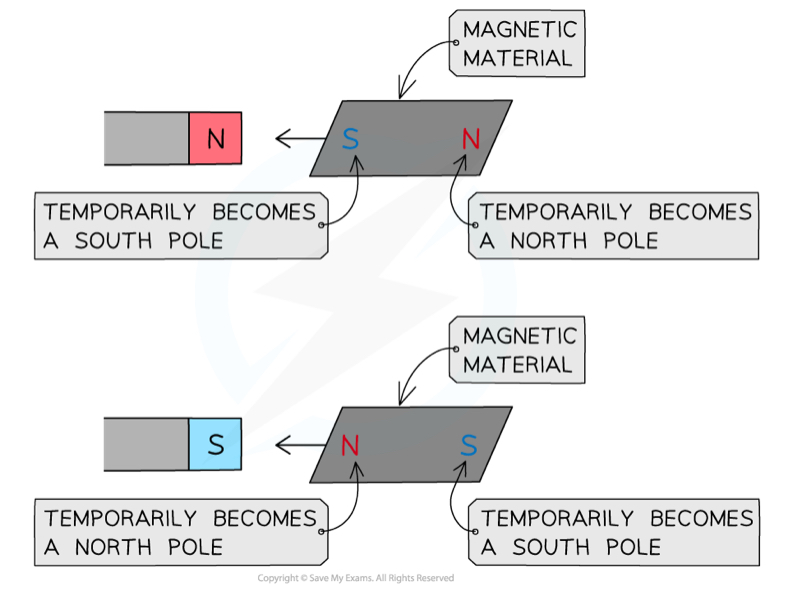
All magnets are surrounded by a magnetic field. A magnetic field is defined as:
The region around a magnet where a force acts on another magnet or on a magnetic material (such as iron, steel, cobalt and nickel).
Magnetic field lines are used to represent…
The strength
The direction
… of that magnetic field
The direction of the magnetic field is shown by…
arrows
The strength of the magnetic field is shown by…
The spacing of the magnetic field lines
…close together = strong
…far apart = weak
Rules which need to be followed when drawing magnetic field lines:
Always go from North to South (indicated by arrow)
Must never touch or cross other field lines
A uniform magnetic field:
Produced in the gaps between opposite poles.
Created when two opposite poles are held close together
Same strength and direction at all points … which means equal spacing between lines and same direction.
Magnetic field around a bar magnet
Magnetic field is strongest at the poles - where field lines are closest together
Magnetic field becomes weaker as distance from the magnet increases - lines are getting further apart
Image of magnetic field lines between bar magnets

Plotting magnetic fields
Investigated using a plotting compass
Arrow of compass represents the north pole
Draw dots from the edges of the arrow to show direction …etc
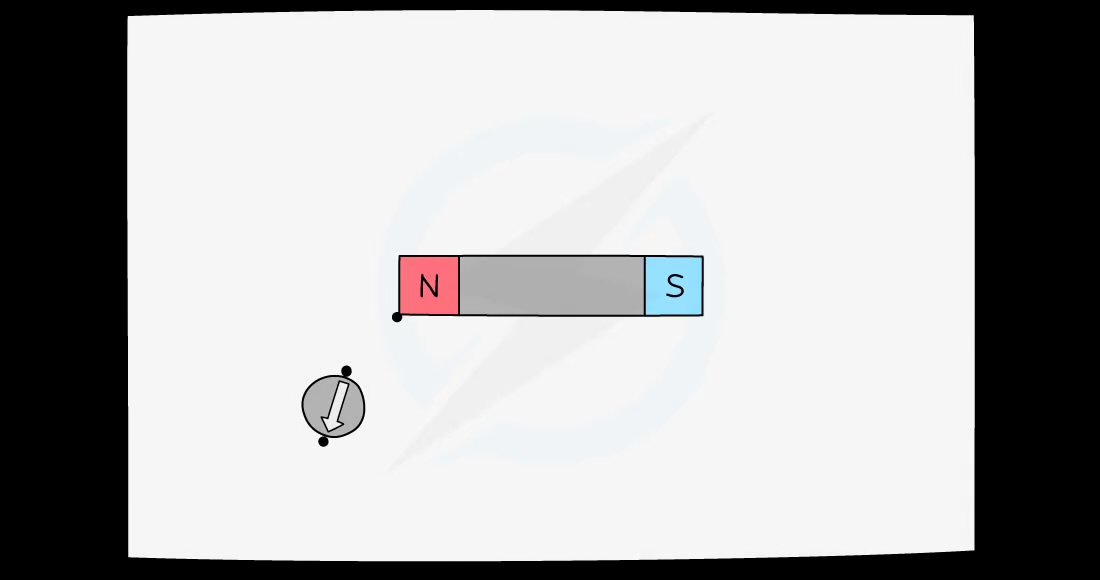
Evidence of the earth’s magnetic field
In the absence of any magnet or magnetic materials, a magnetic compass will always point north
This is evidence that the core of the earth is magnetic and creates its own magnetic fiekd
The earth’s magnetic field is
Similar to that of a bar magnet

Compass in relation to earth’s poles
On Earth, the north arrow on a magnetic compass will point towards the geographic North Pole (in the Arctic Ocean)
This is because the geographic North Pole is a magnetic south pole (the magnetic field lines point out of the pole)
The north pole of the magnetic compass is attracted to the Earth's magnetic south pole
Diagram of the earth’s poles
The geographic South Pole (in Antarctica) is a magnetic north pole (the magnetic field lines point into the pole)
The north pole of the magnetic compass is repelled from the Earth's magnetic north pole
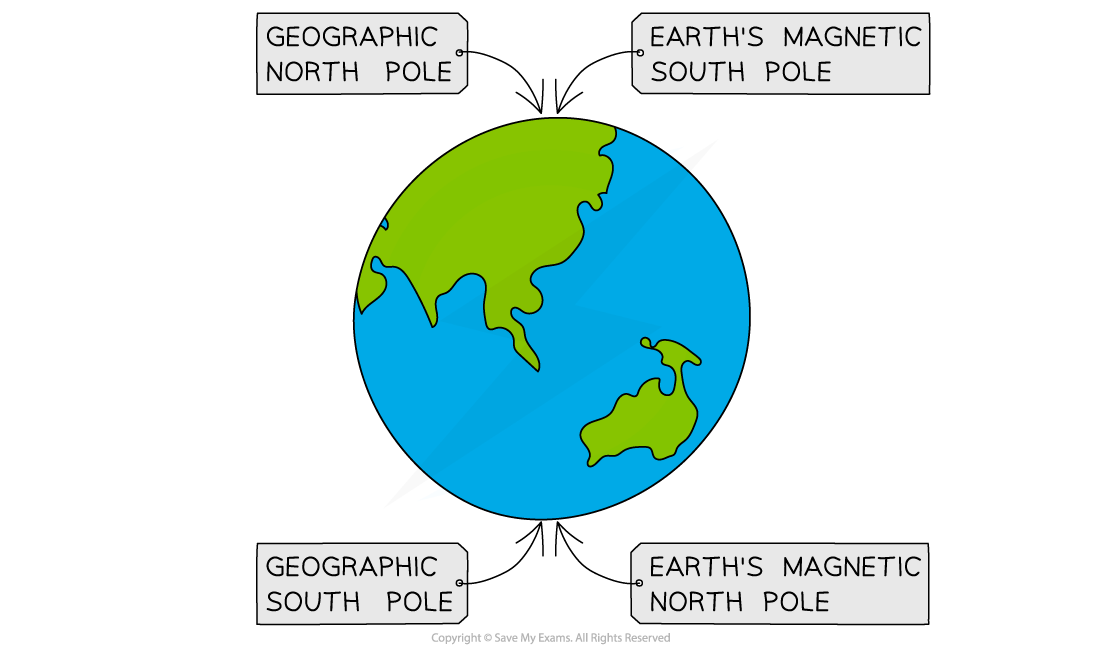
Conducting wire
When a current flows through a conducting wire a magnetic field is produced around the wire
A conducting wire in any wire that has current flowing through it
The shape and direction of the magnetic field can be investigated using…
… plotting compasses
The compasses would produce a magnetic field lines pattern that would look like the following:
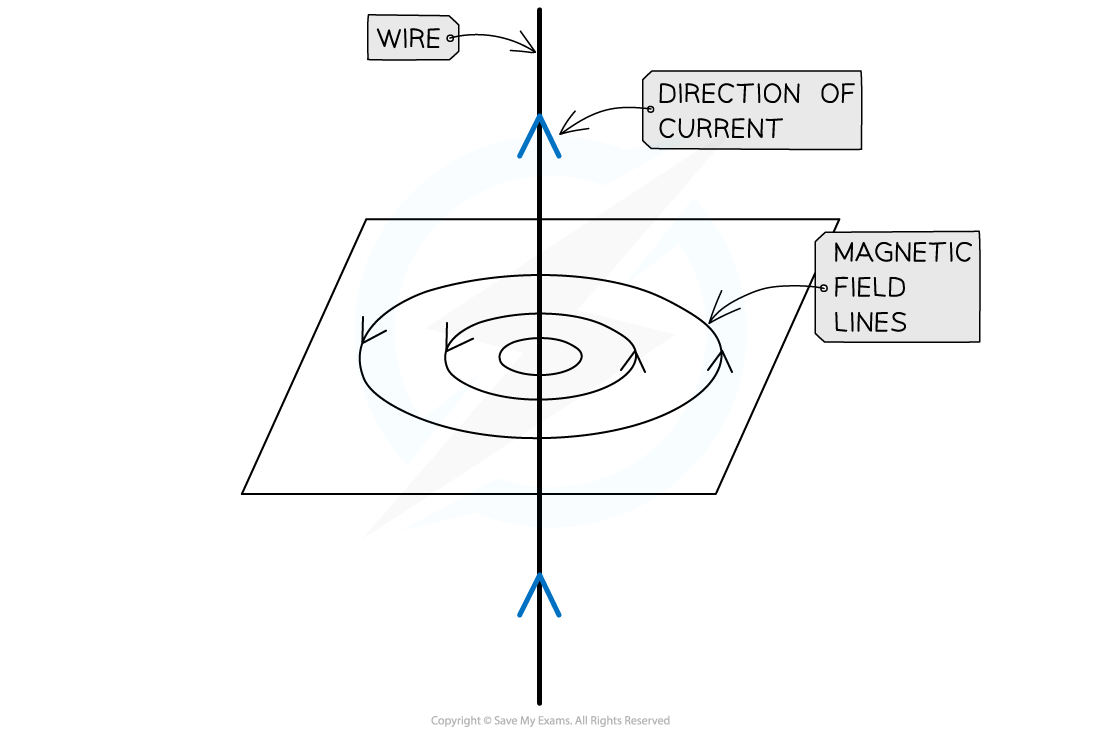
Concentric circles of magnetic field
The magnetic field is made up of concentric circles in a conducting wire… this circular field pattern indicates that the magnetic field around a current carrying wire has no poles
As the distance from the wire increases, the circles get further apart… this shows that the magnetic field is strongest closest to the wire and gets weaker as the distance from the wire increases
Right-hand thumb rule
… can be used to work out the direction of the magnetic field
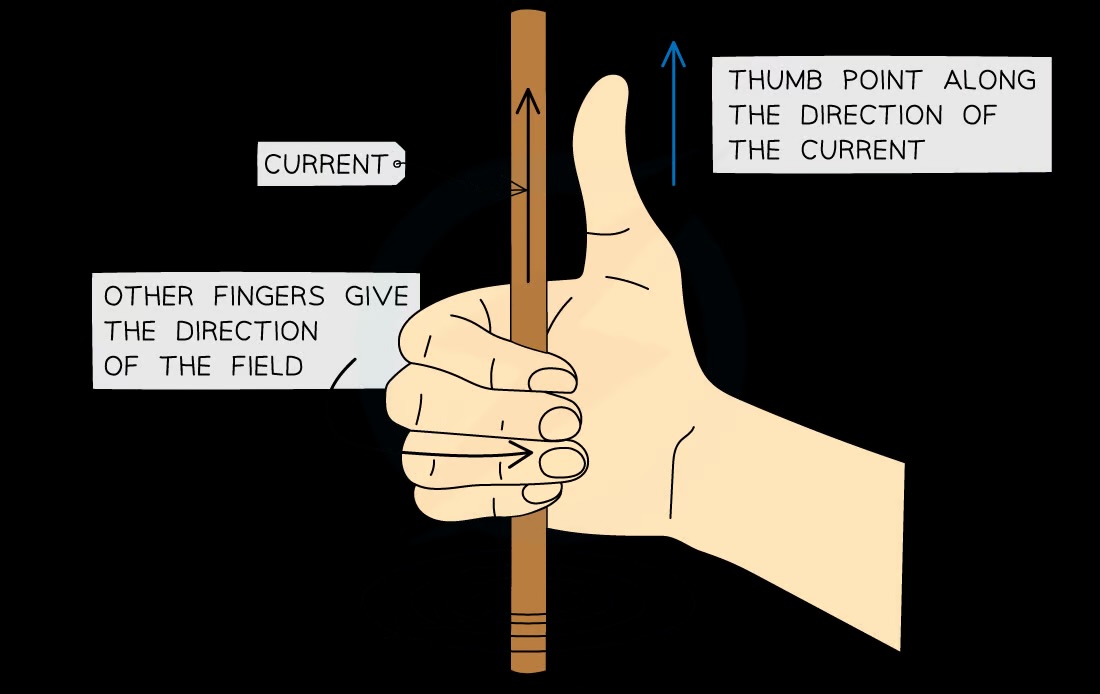
A circle with a dot in the centre shows that current is…
A circle with a cross in the centre shows that current is…
… flowing out of the plane
… flowing into the plane
Strength of magnetic field depends on:
Size of the current
The distance from the long straight conductor (such as a wire)
… larger current = larger magnetic field
… greater distance from conductor = weaker magnetic field
A solenoid
When a wire is looped into a coil, the magnetic field lines circle around each part of the coil, passing through the centre of it.
To increase the strength of the magnetic field around the wire, it should be coiled to form a solenoid
The magnetic field around the solenoid is similar to that of a bar magnet

Solenoid’s magnetic field
The magnetic field inside the solenoid is strong and uniform
Inside a solenoid, the fields from individual coils… add together to form a very strong almost uniform field along the centre of the solenoid …cancel to give a weaker field outside the solenoid
How to work out poles of a solenoid
One end of solenoid behaves like the north pole, the other like the south pole.
To work out the polarity of each end of the solenoid it needs to be viewed from the end
If the current is travelling around in a clockwise direction then it is the south pole
If the current is travelling around in an anticlockwise direction that it is the north pole
If current changes direction…
If there is no current…
…then the north and south poles will be reversed
…flowing through the wire then there will be no magnetic field produced around or through the solenoid
The strength of the magnetic field produced around a solenoid can be increased by:
Increasing the size of the current which is flowing through the wire
Increasing the number of turns in the coil in a given length
Reducing the length of the wire and maintaining the number of turns
Adding an iron core through the centre of the coils
Iron core
The iron core will become an induced magnet when current is flowing through the coils
The magnetic field produced from the solenoid and the iron core will create a much stronger magnet overall
The motor effect occurs:
When a wire with current flowing through it is placed in a magnetic field and experiences a force
The effect is a result of…
…two interacting magnetic fields.
One is produced around the wire due to the current flowing through it
The second is the magnetic field into which the wire is placed, for example, between two magnets
As a result of the interactions of the two magnetic fields, the wire will experience a force.
Diagram
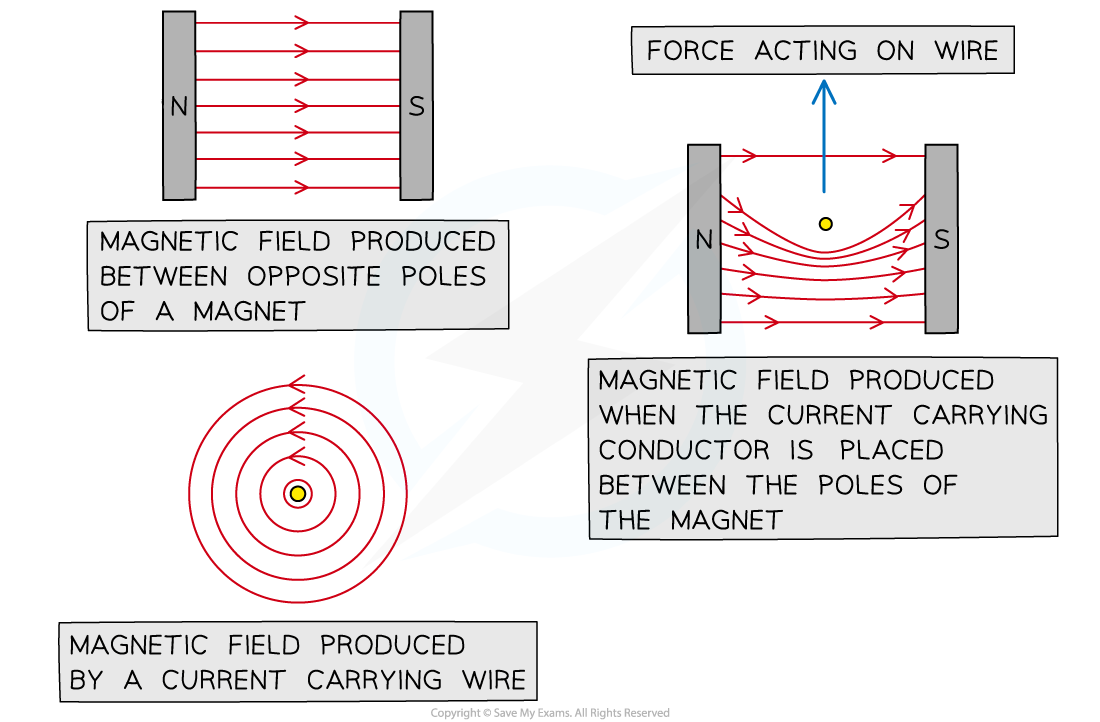
Diagram 2

Magnetic forces are due to…
Interactions between magnetic fields,
Stronger magnetic fields produce stronger forces and vice versa
For a current carrying conductor, the size of the force exerted by the magnetic fields can be increased by:
Increasing the amount of current flowing through the wire… this will increase the magnetic field around the wire
Using stronger magnets… this will increase the magnetic field between the poles of the magnet
Placing the wire at 90 degrees to the direction of the magnetic field lines between the poles of the magnet…this will result in the maximum interactions between the two magnetic fields
If the two magnetic fields are parallel…
…there will be no interaction between the two magnetic fields and therefore no force produced
Fleming’s left hand rule
The direction of the force on a current carrying wire depends on the direction of the current and the direction of the magnetic field. → all three will be perpendicular to each other… this means that sometimes the force could be into and out of the page (in 3D).
Direction of the force can be worked out by using Fleming’s left-hand rule
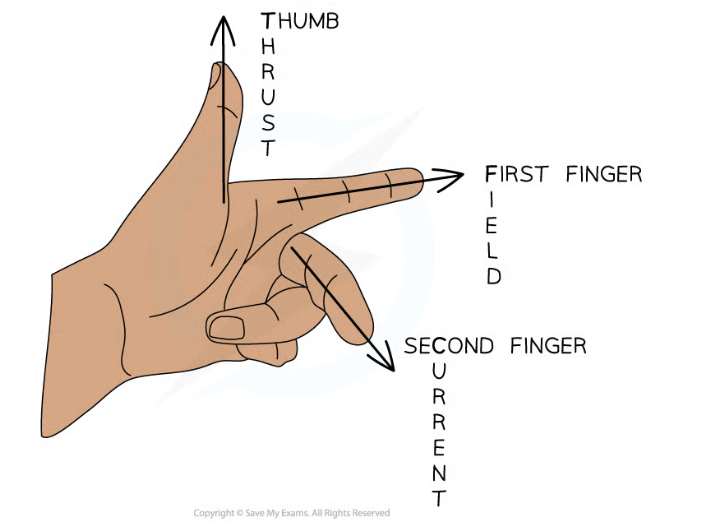
The size of the force acting on a current-carrying wire in a magnetic field can be calculated using tthe equation:
F = BIL
Where:
F = force acting on current-carrying wire in newtons (N)
B = magnetic flux density (which is the strength of the magnetic field) in tesla (N/A m)
I = current flowing through the conductor in amps (A)
L = length of the conductor that is in the magnetic field in metres (m)
The motor effect can be used to create a simple d.c. electric motor.
The force on a current carrying coil is used to make it rotate in a single direction
The simple d.c. motor consists of
a coil of wire (which is free to rotate) positioned in a uniform magnetic field
The coil of wire when horizontal, forms a complete circuit with a cell… the coil is attached to a split ring (a circular tube of metal split in two) …the split ring is connected in a circuit with the cell via contact with conducting carbon bushes
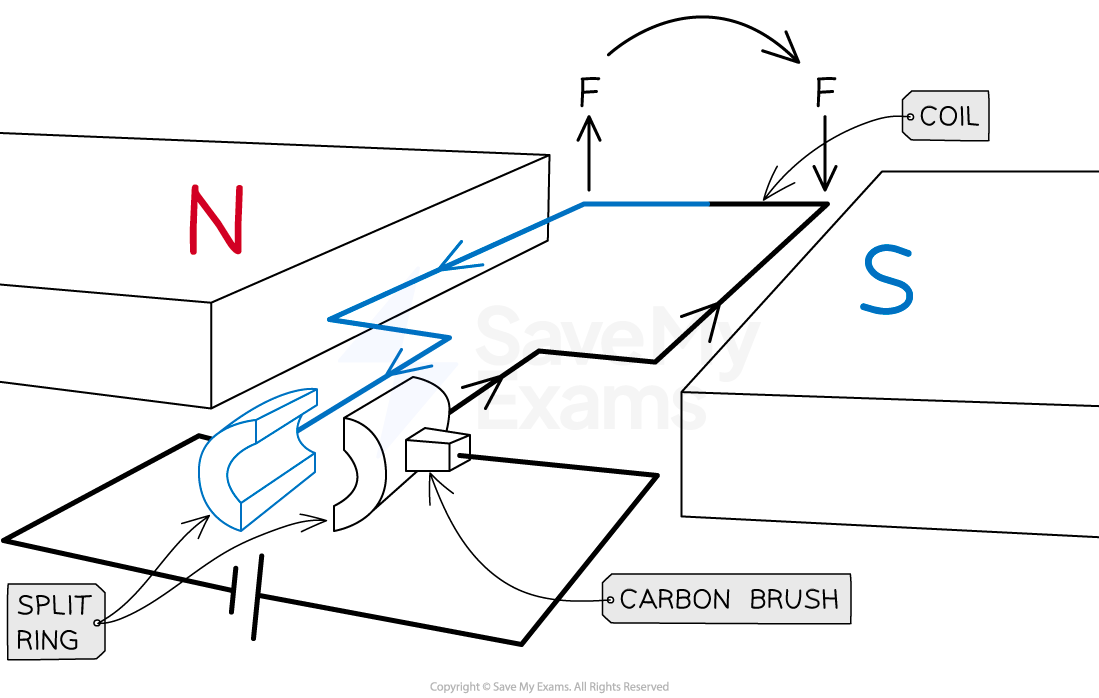
Current flowing through the coil produces a magnetic field
This magnetic field interacts with the uniform external field, so a force is exerted on the wire
Forces act in opposite directions on each side of the coil, causing it to rotate:
On the blue side of the coil, current travels towards the cell so the force acts upwards (using fleming’s left hand rule)
On the black side, current flows away from the cell so the force acts downwards
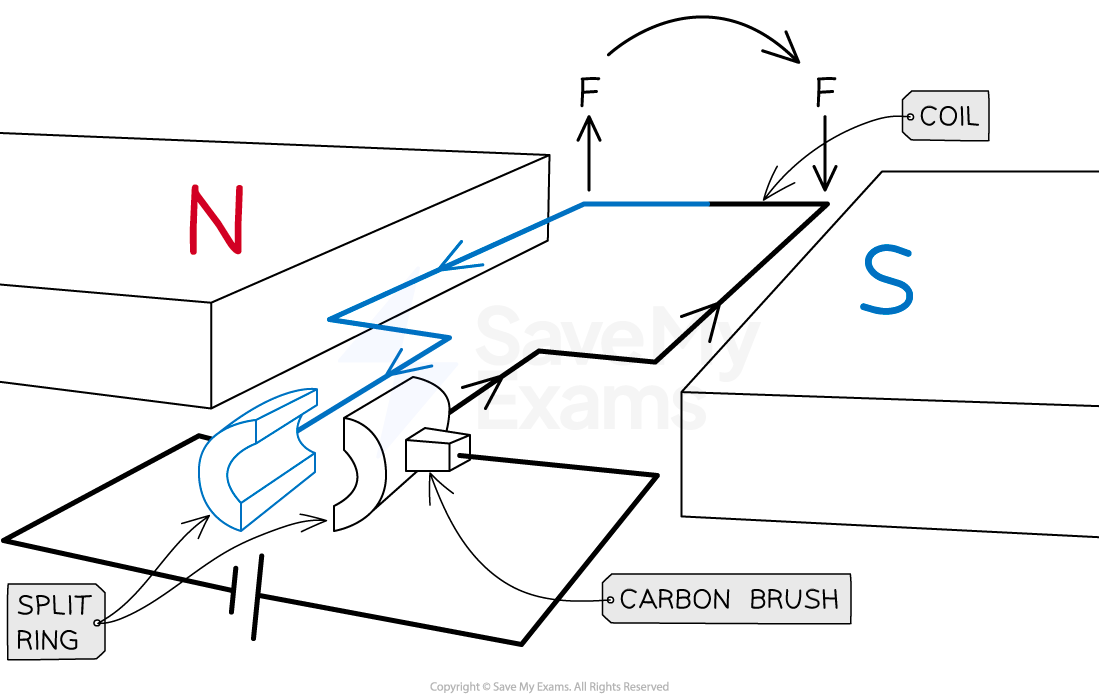
Once the coil has rotated 90 degrees…
The split ring is no longer in contact with the brushes, so no current flows through the coil so no forces act.

Even though no force acts…
The momentum of the coil causes the coil to continue to rotate slightly
The split ring reconnects with the carbon brushes and current flows through the coil again
Now the blue side is on the right and the black side is on the left
Current still flows toward the cell on the left and away from the cell on the right, even though the coil has flipped.
The black side of the coil experiences an upward force on the left and the blue side experiences a downward force on the right
The coil continues to rotate in the same direction forming a continuously spinning motor.
The speed at which the coil rotates can be increased by:
Increasing the current
Using a stronger magnet
The direction of rotation of coil in the d.c. motor can be changed by:
Reversing the direction of the current supply
Reversing the direction of the magnetic field by reversing the poles of the magnet
The force supplied by the motor can be increased by:
Increasing the current in the coil
Increasing the strength of the magnetic field
Adding more turns to the coil